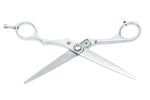

Scissor tension refers to how tight or loosen your scissors’ screw is. It’s a crucial part to mastering your bladework and ensuring the longevity of your most trusted tool.
The proper calibration of scissor tension is required so you can suit the scissors’ cutting ability to the force and movement of your hand.
Misuse or accidental damage can distort your scissors and dislodge the screw a little. Once the tension gets a little loose, you’ll find it harder to manoeuvre and cut as easily as you used to.
Read on to know how to realign scissors to get the perfect tension so you can always achieve a clean cut and keep your shears lasting for decades.
How scissor tension works

A pair of scissors is kept together at a central point called a pivot with the help of a screw.
When the blades are screwed together, a spring force is present to maintain contact between the cutting edges while you cut. A loose screw removes this spring force. When you try cutting using shears without spring force, the hair strands bend.
Diagnosing your scissor tension
You can test whether your scissors are too loose by raising a pair of scissors, opening them fully like a cross with one blade pointing upwards, then allowing them to fall.
If they’re shut together after closing, you probably have loose blade tension. Properly aligned scissors manage to stay open up a bit.
If your scissors seem dull, they might just have gotten loose. In any case, they need to be realigned and tightened.
Realigning your hair scissors

Now, let’s discuss the steps on how to realign scissors to get a perfect tension.
- Clean your scissors. The shears should be completely free of hair, dust or other particles that can damage the screws.
- Always lubricate your scissor screw before doing a realignment. This will help loosen the screw up significantly while you adjust it, as well as reducing the risk for further damage.
- Use the adjuster to realign your scissors. All scissor screws have a type of adjuster on them that may or may not require tools. Remember to adjust the screw tension in increments of about 1/16th inch or one click for maximum precision.
- Dial-Spring-Tension System. This is a popular adjuster option for many scissor models because it doesn’t need any tools. You can simply twist the dial around to tighten or loosen the spring to the desired tension. Again, try to adjust in tiny increments.
- Simple Screw. Older or classical variants of a pair of scissors have an exposed screw that needs a screwdriver to adjust. Once the screws get loose, simply slot your screwdriver in and turn it clockwise until it passes the scissor tension diagnostic test above.
- Special Tension Adjusting Screw. Some scissor-making companies produce models that require a specialised tool to adjust the screw. These tension-adjusting tools work far better than a generic screwdriver, but they might be inconvenient to misplace. Be careful not to lose them.
Comments
-
I didn’t know you could adjust hair-cutting scissors like this. I guess you can do the same thing with any type of scissors or shears but I could be wrong. I’ll check out my scissors (just regular, nothing like barber shears or anything for cutting hair) to see if they have that doohickey for realigning things.
Blog posts
